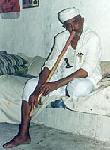 Almotamar Net
Almotamar Net - Based on research in Hodeidah, Zabid and Al-Garrahi, focused on the cultural and social Tihama arts, I came up last week with a startling discovery.
In Hodeidah city, I met some of the people interested in arts, literature and education. At the Cultural Forum, I met Sheikh Mansour Wasel, member of parliament and adviser to the Forum, and Ahmed Salem Bajil, head of the Cultural Forum. They and many others, helped me understand detailed aspects of Tihama art, which I will explain in a series of issues of the Yemen Times.
Let me start with one discovery that truly amazed me, and which had a magical effect on my whole journey. It was an instrument called "Al-Khallool".
At the first glance, I thought that this instrument was some kind of cudgel for protection, or a stick used for herding sheep. But I soon discovered that this one meter long stick was actually a musical wind instrument, i.e., a flute. Not only did it look too large or long to use, but it only had two large holes far away from the opening for blowing in. My amazement increased as the scene unfolded in front of my eyes.
The owner neatly held it with his hands, and played it, producing melodious music. The instrument was so long that in order to keep both his fingers on the two holes, he had to lean his head a little to the left to be able to blow through it. It seemed like an awkward task, but he managed, perhaps because he was used to it.
The mystery of Al-Khallool was not reported by any other newspaper or any other media. I really felt sorry that such a historic and melodious instrument was ignored. This flute is said to be the oldest ever in Yemen.
Everyone I met assured me that the Al-Khallool indeed is the oldest musical instrument in Yemen. They claim that it is one of the oldest musical instruments in the history of mankind.
References to it go back some five hundred years - to the time of the Turkish conquest and the wars between them and the competing Portuguese forces.
Unfortunately, no one knows where the instrument originated. This instrument was used by the farmers and the Tihama people in their festivals, celebrations and entertainments. It was quite puzzling to hear that this instrument has been in use even long before the Turkish conquest. In fact, the owner claims with surprising confidence that the flute in his hand is of the same type used by the Prophet David around 3000 years ago. There is no way to verify such claims.
Scientists will have to test the actual age of the instrument. What we do know is that this strange instrument has become the base of various social Tihama arts the dances of "Alhaqfa", Al-Saif Al-Yamani (The Yemeni sword), the Camel Dance, etc. Since these dances have evolved over a long time, the instrument must have existed for a long time.
This instrument was used in nightly entertainment which often lasted until the next morning. The exciting thing about this instrument is that it produces excellent music, with a sad thick sound that can not be separated from the poetry. Once I listened to its music, it gave me a feeling of the past, the memories, the old history, and the simplicity of the life of the Tihamian people. While playing with its tones, the Tihami person using it had been trying to get a sound like "Da'ood' which is the name of Prophet David in Arabic. It was quite true, it did speak the word "Dawood' in a sad and magical manner.
Al-Khallool was also used by many people who used to travel on camels. It has been said that when the camels listened to this music, they shake their necks and walk for extremely long distances. Tihamians claim that this is how the camel dance actually originated in the Tihama. This instrument has been distinguished by its strange length and the holes and grooves, as I saw it with one of Tihamian citizens who told me that he had inherited this instrument from his deceased father, who taught him how to use it. We asked him how you would make a similar instrument? He simply said that not only would no one from the new or previous generation know how to construct one, they would even not be able to use it. When I calculated his and his fathers age it was around 150 years, he also said that he will pass it on to his son and grand son as he has inherited it from his father and grandfather. This drives us to make a very important conclusion about the artistic position of this instrument, which should be studied so that we can discover the secrets behind it. I concluded that even with only its documented history, Al-Khallool is still a very old and valuable instrument.
The Al-Khallool is quite unique and can easily be distinguished from the newer generation flutes used today. As we all know, today's flutes are made of either plastic or copper and have around 5 to 6 holes. They are also around 20 to 40cm in length. However, Al-Khallool is cut from an old sugar-cane's and is around one meter in length, it has only one open hole at the top. The other end of the instrument is closed and carved. The instrument has only two holes which are not parallel and the distance between these holes is around 15 to 20 cm for breathing. The person who plays this instrument needs to have good lungs so that the music can be continuous. Being played with one finger of each hand, the Al-Khallool is quite awkward to use. It is very difficult to obtain notes from classical music. It does not even have any musical scale. The sound circulates around itself in a very limited path with an incomplete musical tone, which can be distinguished by the ear from among any other musical instrument in the world. Some claim that this indicates that this instrument was made in the old ages when musical scales were not known. It is a historical musical instrument that produces previously unheard magical tones.
Al-Khallool is an important part of Yemen's heritage from the old ages through which the Tihamians found their own cultural music, which they see as essential to pass on to the next generation. This instrument has a unique progression through its possessors in Yemen. No one was able to correctly identify its age and explain its workings.
Al-Khallool is not widely known today because of the difficulty of its use and its inability to generate today's music tones. This leads to ignorance and a shift to the new flutes produced and used today.
In the end, one cannot help wondering how this instrument came all the way from Israel and the Prophet David, to the coast of the Tihama. Could it be that what we call Al-Khallool today is in fact the same instrument the Prophet David used? I can never describe how tears filled my eyes when I heard the music of Al-Khallool. It wasn't only music that I heard. It was history itself being played in a sad way. The sound of Al-Khallool will definitely stay in my mind forever, reminding me of the sounds of the past.

